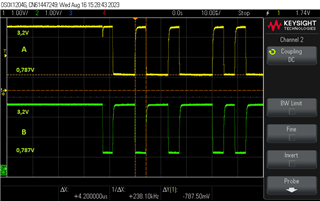Hi,
After a conversation with Jonard at Customer Support sends the task on here.
I looked at that drawing, but I don't understand if those resistors should be included or not.
Added pictures of both signals, A and B with / without pull-up resistor.
I don't know what voltage level those pulses should be with. There is talk of high and low level, but in our case it should be 3.2V and 0V, which is not shown, either with or without pull-up resistor.
Without this resistor, the voltage level appears to reach half of the total voltage when no messages are sent.
The scope shows that the signal is reduced without these resistors.
All this gives rise to several questions.
The first question is whether it is correct with both pull-ups. Will one pull-up to a high level and the other to a low level?
In which of these, A or B should have a high level, or both?
The resistors are 1K, what is the effect on the signal if we increase the resistor?
I see that there is an error with the resistors on my schematic, a double has been added. So we removed a couple.
should the resistors be at the input to the chip or can they be connected after the series resistors?
Finally, we have removed all the resistor and the system works flawlessly with or without the them.
We use RS485 which is split into µC and the display with a short length of approx. 150 mm, where the communication is connected to another three µC.
I'm new to this with RS485 and really need help with this, hoping we get a slightly more thorough explanation about these counter starters that are labeled these are "reserved and unpopulated".
Hope you understand my concerns.
Regards
Jose



